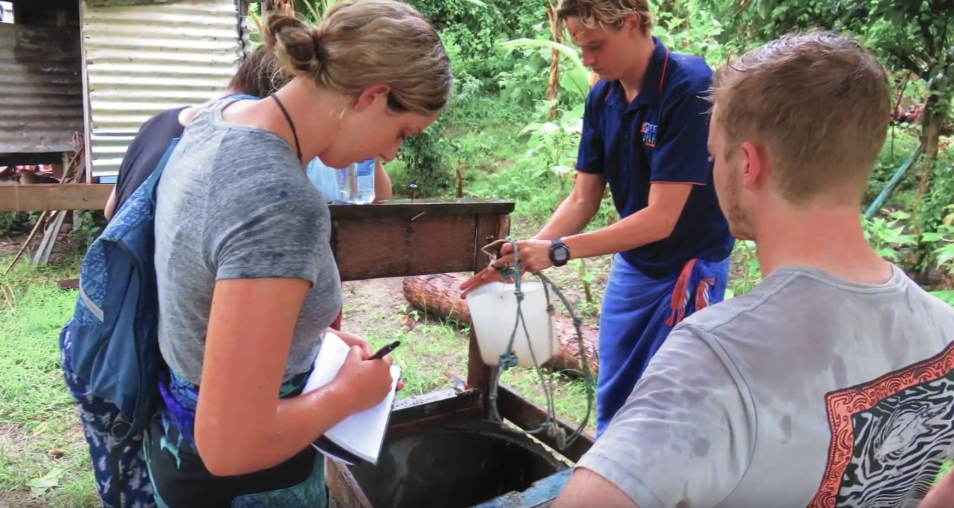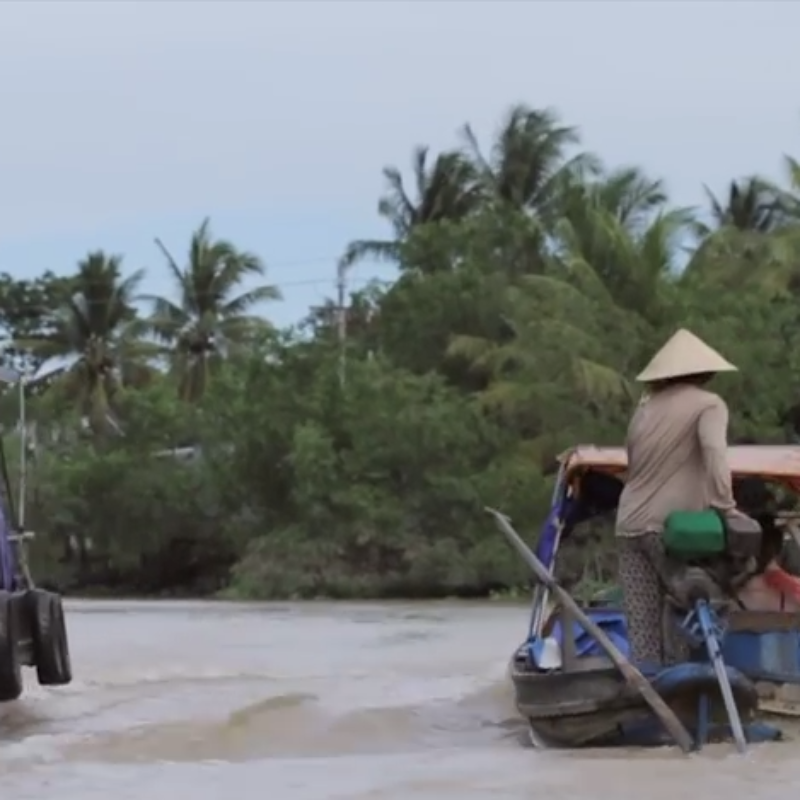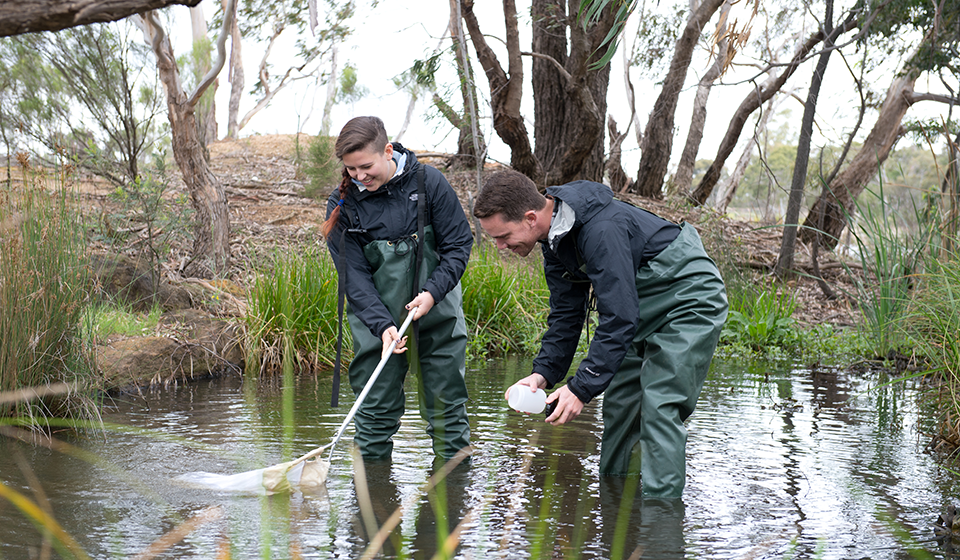TEXT ON SCREEN: The Vietnam Environment Project. Part one. Since 2001, RMIT has sent a team of students to Vietnam to reseach environmental issues. In 2012 students looked at water management issues in Ho Chi Minh City. RMIT logo.
AUDIO: Ambient music.
VISUAL: Scott Breschkin at an angle to the camera against a black background. A caption reads: “Scott Breschkin, Environmental Science Student, RMIT University.”
SCOTT SPEAKS: To be able to come here and undertake something that’s quite, sort of outside what we would normally get to do and quite challenging I think is going to be very rewarding.
VISUAL: John Feil at an angle to the camera against a black background. A caption reads: “John Fiel, Engineering, Environmental Engineering, student, RMIT University.”
JOHN SPEAKS: The biggest thing for me was the experience, getting experience with people of different disciplines.
VISUAL: Melissa Miller at an angle to the camera against a black background. A caption reads: “Melissa Miller, Environmental Science, Social Science, Environment student, RMIT University.”
MELISSA SPEAKS: I’m not really sure exactly what is out there for me and I’m hoping to get that out of this experience.
VISUAL: Busy Vietnam street at sundown. There are a lot of shops and motorbikes, cuts to footage of students talking in the streets at night, and close ups of the traffic.
VISUAL: Scott Breschkin talking to someone off camera.
SCOTT SPEAKS: So the project that we’re looking at is focusing on climate change impacts on water resources in Ho Chi Minh City and we’re looking to make recommendations for adaptations in new development areas.
VISUAL: New development areas in Ho Chi Min. There is a body of water, men working on a roof and a woman watering plants.
SCOTT SPEAKS: How do we make these sustainable? How people dispose of their waste and also changing their perspective on what water they can use and what are different uses they can use for water.
VISUAL: Scott Breschkin talking to camera, cut with shots of Scott and fellow students talking with people of the streets and at a university in Vietnam.
SCOTT SPEAKS: So we aim to get a lot of our information we’re conducting interview with professionals in the industry as well as people from universities and government and local authorities, so that’ll be a major source of information.
VISUAL: Students commuting, walking in different buildings and attending presentations.
JOHN VOICEOVER: The week’s going to be pretty full. So lots of transfers, meeting between buildings, and then presentations go for a couple of hours.
VISUAL: Shots of the students around Ho Chi Min city, looking at city plans, and aerial images of a large intersection the Phu My Hung new urban development.
SCOTT VOICEOVER: I guess the major benefit to the project being able to come here to Vietnam is just to get that real hands on experience, talking to people, meeting people, seeing the application of what you’re researching and hopefully having a finished product, like if we can provide some sort of valuable insights that could be used in the future would be like a really big achievement I think for all of us.
VISUAL: Students in a classroom at HCMC University of Technology, there are Vietnamese and Australian students working together.
VISUAL: Man riding motorbike against a backdrop of tropical trees and roadside markets, followed by footage from the inside of a car travelling across a bridge.
TEXT ON SCREEN: College of Environment and Natural Resources, Can Tho.
VISUAL: Students looking at seedlings. Followed by students in a lecture theatre.
VISUAL: Montage of water taxi’s in Vietnam, different waterways, car driving the rain and the students.
VISUAL: Scott working in a classroom on a laptop.
SCOTT SPEAKS: So we’re in our second week now of the project where we’re required to start collating and putting together all the information that we’ve gathered over the last week and through our research over the course of the project.
VISUAL: Sarah addresses in camera, intercut with students working together. A caption reads: “Sarah Lawless, Social Science, Environment, Student, RMIT University.”
SARAH SPEAKS: We can actually start to take action on the report and it’s not just absorbing absorbing, but it’s also the part where we really have to work hard and work well together.
VISUAL: Laura facing the camera, intercut with scenes of the students working together in a classroom. A caption reads: “Laura Fragopoulos. Social Science, Environment, student. RMIT university.”
LAURA SPEAKS: When it’s coming down to the crunch now we have to sort of make decision and people that are given a job to do, there should be an element of trust that they’re going to be able to do it. Being quite organised is a challenge.
VISUAL: Gemma addressing the camera with a white background. A caption reads: “Gemma Arthurson. Engineering, Environmental Engineering, international studies student, RMIT university.”
GEMMA SPEAKS: The report, in only has to be in draft form, which is very comforting, because yeah, I definitely don’t think we’ll have the whole thing done but I think that we’ll have some kind of structure to it and we’ll know what we have to do when we get back to Melbourne.
VISUAL: Camera pans down in a large room where students are giving a presentation.
JOHN SPEAKS: So tomorrow the presentation will be in front of all the officials we met in the first week and it’s just a brief overview of how our report’s shaping up and what recommendations we will make.
VISUAL: John speaking to camera. intercut with footage of the presentation.
JOHN SPEAKS: I was a bit frustrated the first week because we kept getting information which kind of painted a fairly bad picture for Vietnam in ten years or twenty years from now.
VISUAL: Gemma facing the camera, cut with footage of students in the field, on a river.
GEMMA SPEAKS: From all the information we gathered about Ho Chi Minh and the issues they face, to actually get out into the field and see that first hand, When we were in that really green and peaceful area, but at the same time you could see a lot of rubbish floating down the river as well and it was sad to see.
VISUAL: John speaking to camera.
JOHN SPEAKS: I sat there very keen to get into the project and found myself on the third, or end of the third day just thinking: Wow. Can we help this or can we actually design a solution for these people?
VISUAL: A large boat floats down a busy river.
JOHN SPEAKS: There was certainly a deflation in the sense the more you looked into it and thought about it the less you were probably able to do.
VISUAL: Man pushing giant rubbish cart down the street.
GEMMA SPEAKS: There’s ways to make changes for social scientists, environmental scientists, environmental engineers and, but in terms of the future I definitely think there’s hope.
UNNAMED WOMAN SPEAKS: It’s quite depressing because you learn about all these issues and how hard it is to change but being here, we’re making a small difference and it makes you feel really good, yeah.
WRITTEN TEXT: Student reports have been used as resource documents by researchers and consultants in Australia and Vietnam, and have provided the basis for a number of water resource management projects in the Mekong region. Part 2 looks at the outcome of the project through the eyes of the students after their return to Melbourne.
VISUAL: Group photo of students on the trip.
VISUAL: Fade to white.
TEXT ON SCREEN: RMIT logo. www.rmit.edu.au Music by Road Camel Branding (www.roadcamel.com.au) and Thrupence (www.jackvenzet.com)
[END TRANSCRIPT]







